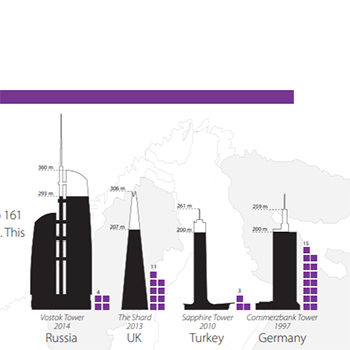Filter by
You must be a CTBUH Member to view this resource.
Eurasia Tower
Steel Peak, Стальная Вершина, Stalnaya Vershina
Building
Completed, 2015
residential / hotel / office
composite
308.9 m / 1,013 ft
72
5
149
965
39
7.1 m/s
212,900 m² / 2,291,637 ft²
You must be a CTBUH Member to view this resource.
You must be a CTBUH Member to view this resource.
Usually involved in the front end design, with a "typical" condition being that of a leadership role through either Schematic Design or Design Development, and then a monitoring role through the CD and CA phases.
The Design Engineer is usually involved in the front end design, typically taking the leadership role in the Schematic Design and Design Development, and then a monitoring role through the CD and CA phases.
The Design Engineer is usually involved in the front end design, typically taking the leadership role in the Schematic Design and Design Development, and then a monitoring role through the CD and CA phases.
Material Supplier refers to organizations which supplied significant systems/materials for a building project (e.g. elevator suppliers, facade suppliers, etc).
You must be a CTBUH Member to view this resource.
Usually involved in the front end design, with a "typical" condition being that of a leadership role through either Schematic Design or Design Development, and then a monitoring role through the CD and CA phases.
The Design Engineer is usually involved in the front end design, typically taking the leadership role in the Schematic Design and Design Development, and then a monitoring role through the CD and CA phases.
The Design Engineer is usually involved in the front end design, typically taking the leadership role in the Schematic Design and Design Development, and then a monitoring role through the CD and CA phases.
The CTBUH lists a project manager when a specific firm has been commissioned to oversee this aspect of a tall building’s design/construction. When the project management efforts are handled by the developer, main contract, or architect, this field will be omitted.
Other Consultant refers to other organizations which provided significant consultation services for a building project (e.g. wind consultants, environmental consultants, fire and life safety consultants, etc).
Material Supplier refers to organizations which supplied significant systems/materials for a building project (e.g. elevator suppliers, facade suppliers, etc).
CTBUH Releases Year in Review: Tall Trends of 2015
19 January 2016 - CTBUH Journal
CTBUH Releases Study on the Past, Present and Future of the European Skyscraper
1 June 2013 - CTBUH Journal
Ermell_ccbysa.jpg)
19 January 2016
Year in Review: Tall Trends of 2015
Jason Gabel, Marty Carver & Marshall Gerometta, CTBUH
CTBUH has determined that 106 buildings of 200 meters’ height or greater were completed around the world in 2015 – setting a new record for...
Located in Moscow City, a newly established central business district, Eurasia Tower is supertall building among cluster of Moscow’s tallest buildings constructed collectively to create a brand new skyline on the city’s east side. Eurasia Tower, also known as Eurasia during its design phase, was the first composite structure to be constructed in Russia utilizing a reinforced concrete core with a perimeter frame of steel. The structural design allows for column-free interior spaces ideal for offices which make up a significant portion of the building’s programming. The building features a bowed exterior made up of closely spaced steel columns which sit upon a belt truss serving as a load transfer for the base of the tower to feature an open lobby on the ground floor.
The tower is comprised of 50 floors of offices and 20 floors of luxury apartments with their own amenity space featuring a pool and gymnasium on level 50. The bright green curtain wall facade transitions from fixed windows through the office floors to operable windows for the residences. At the base of the tower is a podium structure containing a 149 room hotel, boutiques, restaurants, bars, parking and a casino spanning 3,000 square meters . The building then stretches 5 stories below grade across a large site area that is far larger in size than the tower’s footprint.
The building features underground connections to the neighboring buildings of the Moscow City district as well as the Moscow Metro network. The location near the 3rd Ring Road not only further reinforces Eurasia Tower’s connectivity to the greater region, but also ensures the tower will remain a highly visible component of Moscow’s tallest skyline cluster.
Ermell_ccbysa.jpg)
19 January 2016
Year in Review: Tall Trends of 2015
CTBUH has determined that 106 buildings of 200 meters’ height or greater were completed around the world in 2015 – setting a new record for...

01 June 2013
The Past, Present and Future of the European Skyscraper
There are currently 109 skyscrapers over 150 meters in Europe. This number is set to jump to 161 by the end of 2015, meaning that...
19 January 2016
CTBUH has determined that 106 buildings of 200 meters’ height or greater were completed around the world in 2015 – setting a new record for annual tall building completions.
Subscribe below to receive periodic updates from CTBUH on the latest Tall Building and Urban news and CTBUH initiatives, including our monthly newsletter. Fields with a red asterisk (*) next to them are required.
View our privacy policy